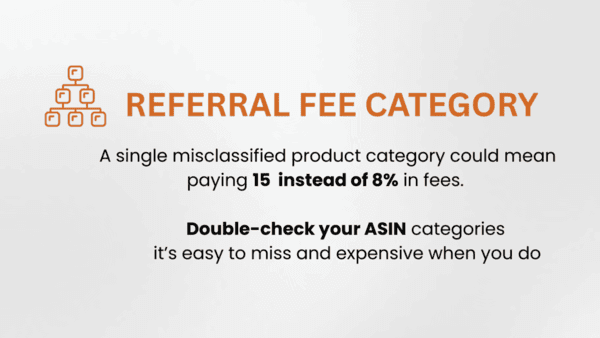Amazon selling is a wonderful way to grow your business, but understanding and having control over the fees of the site is essential to achieve your highest profit. Amazon imposes various fees, including referral fees (a rate on each sale, typically 8-15% depending on the category), Fulfillment by Amazon (FBA) fees for storage and shipping if you avail of their service, and subscription fees for Professional Seller accounts ($39.99/month), among others. These charges have the potential to quickly eat up your margins unless you keep up with them. To manage them best, learn category-specific charges to price cheaply but with profit, use product size and weight to reduce FBA cost to the most, and pay close attention to your inventory in order to avoid long-term storage fees. Stay alert and on top of these, and you can keep more of your hard-earned profit while thriving on Amazon.
1.Referral Fees: The Heart of Amazon’s Fee System

One of the main costs you’ll bump into on Amazon is the referral fee—it’s basically their cut of every sale you make. It’s tied to the type of product you’re selling, so the percentage can shift depending on what’s in your store. Trust me, it’s worth taking a peek at those rates for your items so you’re not caught off guard!
Key Details:
Referral charges between 6% and 45%, with the majority of categories between 8% and 15%.
For example, books have a 15% referral charge, while electronics will be charged less (8%–10%).
Referral fee is charged on the selling price, including shipping charges (if any).
2. Fulfillment Fees: Applying Amazon’s FBA Service Charges
If you’re using Fulfilled by Amazon (FBA), Amazon will handle storage, packing, and shipping of your products. While this service offers convenience and access to Prime customers, it comes with its own set of fees.
Key Details:
FBA Fulfillment charges are weight- and dimension-based on your product.
On light products (less than 1 lb), it’s roughly $2.50 per unit. Heavy items (more than 2 lbs) are as high as $10.
FBA charges can be a monumental profitability factor, especially on less expensive products.
Example:
A $15 product can cost you a $2.50 referral fee, but if it’s light and small, adding your fulfillment fee could tack on another $3–$4. So the fees for the product as a whole are 40-50% of the sale price.
3. FBA Storage Fees: The Price of Storing Your Products

If your products are being stored in Amazon’s fulfillment centers, you will be paying for storage charges. These are seasonal and based on product size.
Key Facts:
Monthly Storage Charges: Based on the amount (in cubic feet) of your merchandise.
Standard-size items are billed $0.75 per cubic foot from January to September and $2.40 per cubic foot during
the holiday period from October to December.
Long-Term Storage Charges: In case the products are stored for over 365 days, Amazon levies an extra long-term storage fee of $6.90 per unit or 50% of the product’s current selling price, whichever is lower.
4. Dimensional Weight and Oversized Products

Dimensional weight is something to be taken into account seriously when it comes to Amazon shipping charges. If your items are heavy but large in dimensions, you might end up paying by dimensional weight instead of actual weight.
Key Information:
Dimensional weight comes from dividing the product’s length times width times height by a constant (139 for average-sized products in the U.S.).
As an example, an oversized package of a 2 lb product might be charged as if it were a 4 lb product, which would
significantly increase fulfillment cost.
Tip: Amazon also bills extra for fulfillment and storage of oversized products. To lower this expense in those situations, reformulating packaging of products or marketing reduced-size merchandise could minimize spending.
5. How to Manage and Minimize Amazon Fees

Now that we understand the major Amazon fees, let’s explore practical steps you can take to manage and reduce them effectively.
Regularly Review Fee Structures
Categorization matters: Ensure that your products are listed under the correct
category. A simple misclassification could mean higher referral fees.
Optimize product size: Consider adjusting your packaging or offering smaller versions of
bulky products to lower dimensional weight fees.
Keep an Eye on Inventory
FBA Inventory Health Reports: Regularly review your inventory health to
avoid long-term storage fees. Remove slow-moving inventory or liquidate excess stock to
save on storage costs.
Seasonal Stock Management: Be strategic about stock levels, particularly
around the holiday season when storage fees increase. You don’t want to overstock during
this period.
Price Optimization
Adjust your pricing to absorb the increased fees without compromising your profitability.
Be mindful that small adjustments to product pricing could impact the effectiveness of your campaigns or sales volume.
Use Amazon’s Fee Tools
FBA Revenue Calculator: Amazon provides a tool to calculate the profitability of using FBA for specific products. This allows you to determine if FBA fees make sense for your business.
Seller Central Reports: Use Amazon’s detailed reports to analyze your costs and margins per product and identify potential areas for cost optimization.
Conclusion:
It’s having knowledge about the fee schedule at Amazon that helps you get maximum profit through the platform. By having the ability to manage referral fees, fulfillment fees, storage, and product dimensions, you can preserve margins and reap success in the long run. Maintaining knowledge of costs and health of inventories on an as-needed basis, and packaging and pricing adjustment, will gain you a competitive edge in the high-speed environment of e-commerce.

